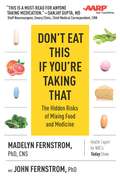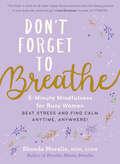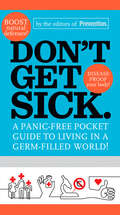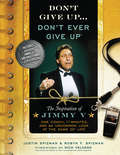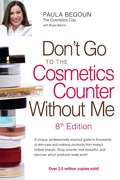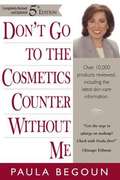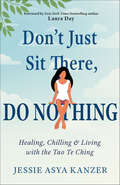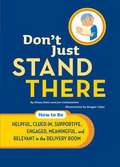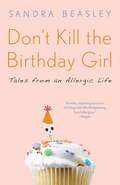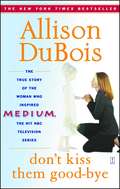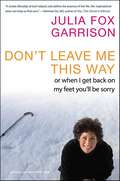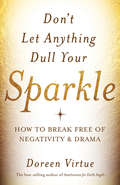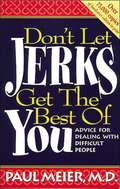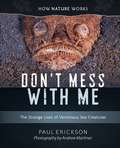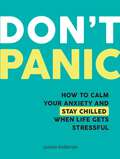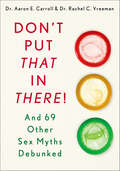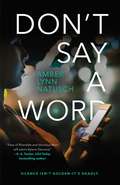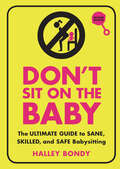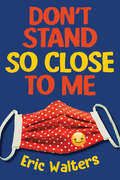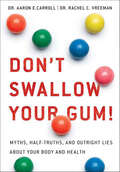- Table View
- List View
Don't Eat This If You're Taking That: The Hidden Risks of Mixing Food and Medicine
by Madelyn Fernstrom John FernstromNBC Today show nutrition and diet guru Madelyn Fernstrom and award-winning neuroscientist and pharmacologist John Fernstrom -partnering with AARP- present the ultimate guide to food and medicine interaction.Millions of Americans take prescription drugs to treat diabetes, high blood pressure, heart disease, or other conditions. But beware: The foods you eat and the medications you take could be working against each other.Don’t Eat This If You’re Taking That takes the mystery out of food and medication interactions. This easy-to-use guide details foods that can interfere with the action of the medication-whether taken for the short or long term. In this book, readers can easily find a medication, see what foods to avoid, and make smart swaps.We all believe a diet rich in colorful fruits and vegetables, lean proteins, whole grains, and low-fat dairy products is part of healthy eating-right? Not always. Dr. Fernstrom explains exactly what foods to avoid when and why. For instance,If you’re taking cholesterol medicine, you should cut out-or cut down on-grapefruit.On a blood thinner? Avoid dark green veggies.If you’re on thyroid medication, nix the soy.And more small diet changes with big health payoffs!As an added bonus, each chapter offers a "Dietary Supplements Alert” box, providing the most up-to-date information on interactions with vitamins, minerals, and other dietary supplements.With this concise, scientifically based guide, consumers can easily personalize their eating plan to work with, not against, their medications.
Don't Eat Your Heart Out Cookbook
by Joseph C. PiscatellaHow to reduce cholesterol, salt, fat and sugar, and still eat tasty food. How to adapt everyday recipes for healthful eating. How to permanently change eating habits. How to read and understand labels. How to lose weight and keep it off. How to handle eating in a restaurant, and more.
Don't Forget to Breathe: 5-minute Mindfulness For Busy Women--beat Stress And Find Calm Anytime, Anywhere!
by Shonda MoralisTake five minutes to reset, refocus, and find calm We’re all overwhelmed at times. Between a career, personal life, and family, finding time for yourself can seem impossible, with an infinite to-do list. Shonda Moralis has been there—and developed a solution. Here are over fifty five-minute “mindful breaks” that help you find energy at any moment: while getting dressed, commuting, or drinking coffee. Breathe mindful breaks promote calm and awareness. Becoming mindful breaks prevent limiting beliefs and boost your confidence. Balance mindful breaks help you craft the life you want. Don’t Forget to Breathe allows you to take time for yourself while doing everything else. Publisher’s note: Don’t Forget to Breathe is an updated and revised edition of Breathe, Empower, Achieve.
Don't Get Sick.: A Panic-Free Pocket Guide to Living in a Germ-Filled World
by Editors of PreventionThe next best thing to a cure for the common cold: proven strategies to outsmart germs and help you stay disease-free.Coming down with the latest bug to make the rounds will never be on anyone's to-do list. After all,who has time to be laid up by, say, a cold or the flu? And now that the germs are getting bigger and badder, there's even more reason to try to stay healthy.Don't Get Sick makes the case for smart self-care as the key to stopping the spread of infectious illness. While germs may not be 100 percent avoidable, there's a lot that people can do to reduce their exposure and strengthen their natural defenses. Drawing on scientific research and expert interviews, Don't Get Sick reveals: • where germs are most likely to linger • how nurses, teachers, and others in high-risk professions manage to outsmart illness • which immune-boosting products really work—and which aren't worth the money Packed with real-world advice, along with a healthy dose of perspective on swine flu and other health risks, Don't Get Sick is a must-have resource for anyone concerned about their health.
Don't Give Up...Don't Ever Give Up
by Justin Spizman Robyn Spizman"If you laugh, you think, and you cry, that's a full day. That's a heck of a day. You do that seven days a week, you're going to have something special. "Jimmy V was a catalyst. He was a dreamer. And he served as an inspiration to so many. Facing his own mortality, he stood tall and found the courage and bravery for one last call to arms. He took the world's biggest stage and delivered some of the world's biggest lessons. These lessons were the heart of the speech and the inspiration for this book. But it all started with a speech. . .
Don't Go to the Cosmetics Counter Without Me
by Paula Begoun Bryan BarronPaula Begoun has been reporting on the beauty industry for more than 25 years. Loved by readers and feared by corporations, she has earned the name of "Cosmetics Cop" for her thorough, authoritative investigations of beauty products and her fierce consumer advocacy. From drugstores and home shopping to department stores and catalogs, Begoun reviews all of the major cosmetic and skin care lines product by product - more than 30,000 in all. Regardless of the price tags, there are good and bad products in almost every line, and with the turn of a page, readers receive concise reviews and fast answers in this comprehensive, totally revised edition. Begoun covers product websites, efficacy, and whether claims such as youth extension are accurate. Individual chapters are devoted to best products, a cosmetic ingredients dictionary, and animal testing. A user-friendly rating system makes finding items worth trying a snap.
Don't Go to the Cosmetics Counter without Me
by Paula BegounBegown's mission is to educate women on the facts that the $45 billion cosmetics industry doesn't want people to know. In her makeup and skincare bible, she deciphers ingredient lists, translates cosmetics-counter beauty babble, and evaluates the worth of virtually every product on the market. This completely revised and expanded edition includes more than 75 new product lines.
Don't Hate, Meditate!: 5 Easy Practices to Get You Through the Hard Sh*t (and into the Good)
by Megan MonahanMeditation instructor, Deepak Chopra protégé, director of Meditation Wanderlust Hollywood, and Lululemon ambassador Megan Monahan presents a no-nonsense guide to meditation for everyday soul-searchers.This modern guide to meditation from instructor Megan Monahan takes readers beyond empty Instagram truisms to the simple yet effective ways to "meditate their way through the bad shit and into the good shit." With a fresh voice and perspective, Monahan presents a set of tools grounded in a meditation technique that is impossible to screw up. With her help, you'll unpack the five spiritual mindsets (Presence, Acceptance, Intention, Nonjudgment, and Trust, aka PAINT) that are key to moving out of constriction and fear and into a more expansive space within yourself and your life. Ultimately, you will quickly notice, at any triggering moment, where you're getting stuck and how to more consciously move through it. The good news? This process is applicable to everything in your life, from missing a flight to seeing your ex's engagement photo on social media to losing your job. Wouldn't it be nice to not be completely leveled by any of those occurrences? Plot twist: After reading this book, taking the quizzes, and doing the themed meditations . . . you won't be!
Don't Just Sit There!: 44 Insights to Get Your Meditation Practice Off the Cushion and Into the Real World
by Biet SimkinDiscover the forty-four laws of life that are the missing link between the desire to meditate and the motivation needed to maintain a regular meditation practice, process the emotional fallout of meditative experiences, and find spiritual fulfillment.Biet Simkin knows from personal experience that finding your way to transformation and mindfulness isn’t always easy. Drawing on hard-won wisdom from her journey through addiction, personal tragedy, and the New York rock-n-roll scene, Biet shares the guidance you’ll need to move from meltdowns to miracles. Don’t Just Sit There! is a guidebook that will empower you to dive into meditation by helping you work through the not-so-peaceful side of achieving peace. With insights on forty-four laws of human experience, it provides week-by-week instructions to process each one. From the Law of Focus to the Law of Desire, these aspects of spiritual life can become obstacles without the tools to properly face them. Experienced and novice meditators alike can benefit from Biet’s frank, freeing advice on how to establish a lifelong practice in an often chaotic modern world. By confronting the disruptive quality of spiritual life, you can motivate yourself to realize the meditative practice of your dreams.
Don't Just Sit There, DO NOTHING: Healing, Chilling, and Living with the Tao Te Ching
by Jessie Asya Kanzer"Stressed-out readers will find her advice a salve in an overly hurried and critical world." —Publisher's Weekly "Jessie Asya Kanzer is like a Taoist Anne Lamott, and she's written a practical and actionable guide." —Joel Fotinos, author of The Prosperity PrinciplesHere are 47 inspirational pieces that are smart, hip, accessible, and rich with insight; Jessie Asya Kanzer's bite-sized stories of struggle, triumph, and contemplation provide a quick burst of mindfulness. Each chapter begins with a verse from the Tao, followed by sharp observations and anecdotes from her own life that give the teachings of Lao Tzu applicability to contemporary life. And each chapter concludes with a "Do Your Tao" section that offers an actionable step, leaving the reader with a sense of grounding and fluidity. Chapters include: "Success Sucks (Sometimes)," "F*ck This, I'm Water," "I Love You, I Not Love You," "The Tao of Babushka," and "Mystics Wear Leggings".
Don't Just Stand There
by Beegee Tolpa Jon Lichtenstein Elissa SteinDon't Just Stand There delivers! Written by a husband and wife team, this guidebook outlines everything an expectant father needs to know to navigate the big day. Dads get clear direction on what to bring, how to calm and soothe, what to say and, more important, what to definitely not say. A chapter on the stages of labor makes it easy to track what's happening when, while guiding mom to mention her preferences ahead of time. With witty illustrations and confidence-inspiring advice throughout, it's an essential for expecting parents.
Don't Kill the Birthday Girl: Tales from an Allergic Life
by Sandra BeasleyA beautifully written and darkly funny journey through the world of the allergic. Like twelve million other Americans, Sandra Beasley suffers from food allergies. Her allergies--severe and lifelong--include dairy, egg, soy, beef, shrimp, pine nuts, cucumbers, cantaloupe, honeydew, mango, macadamias, pistachios, cashews, swordfish, and mustard. Add to that mold, dust, grass and tree pollen, cigarette smoke, dogs, rabbits, horses, and wool, and it's no wonder Sandra felt she had to live her life as "Allergy Girl." When butter is deadly and eggs can make your throat swell shut, cupcakes and other treats of childhood are out of the question--and so Sandra's mother used to warn guests against a toxic, frosting-tinged kiss with "Don't kill the birthday girl!" It may seem that such a person is "not really designed to survive," as one blunt nutritionist declared while visiting Sandra's fourth-grade class. But Sandra has not only survived, she's thrived--now an essayist, editor, and award-winning poet, she has learned to navigate a world in which danger can lurk in an unassuming corn chip. Don't Kill the Birthday Girl is her story. With candor, wit, and a journalist's curiosity, Sandra draws on her own experiences while covering the scientific, cultural, and sociological terrain of allergies. She explains exactly what an allergy is, describes surviving a family reunion in heart-of-Texas beef country with her vegetarian sister, delves into how being allergic has affected her romantic relationships, exposes the dark side of Benadryl, explains how parents can work with schools to protect their allergic children, and details how people with allergies should advocate for themselves in a restaurant. A compelling mix of memoir, cultural history, and science, Don't Kill the Birthday Girl is mandatory reading for the millions of families navigating the world of allergies--and a not-to-be-missed literary treat for the rest of us.From the Hardcover edition.
Don't Kiss Them Good-bye
by Allison DuBois"Death is a funny thing. It brings out the best and worst in people. It casts light on the truth and makes life blindingly clear." Her visions have helped solve crimes; her instincts have helped find missing people; she can predict future events and sense your thoughts. These are some of the extraordinary gifts that define the remarkable Allison DuBois, the real-life medium, wife, and mother whose life is the inspiration for the hit NBC television series Medium. When she was six years old, Allison's deceased great-grandfather came to her with a message for her mother: "I am okay, I am still with you. Tell your mom there's no more pain." Allison shared his comforting words with her mother and thus began a lifetime of creating connections between loved ones and those they have lost. The purpose of her gifts became clearer when Allison worked as an intern in the homicide bureau of the district attorney's office and found that she visualized the crime as she handled the evidence. Allison now works as a profiler on criminal investigations. In this stunning book, Allison shares fascinating stories of her encounters with people who have passed and her adventures as a profiler for various law enforcement organizations. With wit and compassion, Allison shows us what it is like to live with these special gifts and talents and also tells about her struggle to live a normal life as a devoted wife and mother. She shows how learning to accept her own gifts has helped her accept the unique gifts of others and how her compelling desire to relieve the pain of others has helped define her own life, a life committed to the search for ultimate truth. If you have ever questioned whether there is an afterlife, this book will help you see that there is a living energy beyond death.
Don't Leave Me This Way: Or When I Get Back on My Feet You'll Be Sorry
by Julia Fox GarrisonJulia Fox Garrison refused to listen to the professionals she called Dr. Jerk and Dr. Panic, who—after she suffered a massive, debilitating stroke at age thirty-seven—told her she'd probably die, or to Nurse Doom, who ignored her emergency call button. Instead she heeded the advice of kind, gifted Dr. Neuro, who promised her he would "treat your mind as well as your body." Julia figured if she could somehow manage to get herself into a wheelchair, at least she'd always find parking. But after many, many months of hospitalization and rehab—with the help of family, friends, and her own indomitable spirit—Julia not only got into a wheelchair, but she got back out.Don't Leave Me This Way is the funny, inspiring, profoundly moving true story of a woman's fight for her life and dignity—and her determined quest to awaken an entrenched, unfeeling medical community to the fact that there's always a human being inside every patient.
Don't Let Anything Dull Your Sparkle: How To Break Free Of Negativity And Drama
by Doreen VirtueDifficult relationships and challenging circumstances all come down to one thing: drama. In this groundbreaking book, Doreen Virtue guides you through the process of determining your Drama Quotient. You’ll discover how much stress you are unnecessarily tolerating and absorbing from other people and the situations you find yourself in.Doreen explains the physiological reasons why you can become addicted to high-drama relationships, jobs, and lifestyles, and how to heal from this cycle. You’ll come to understand why traumatic events from the past may have triggered post-traumatic symptoms, including anxiety, weight gain, and addictions – and you’ll learn natural and scientifically supported methods for restoring balance to your body and your life.Doreen shows you how to: • Deal with relatives, friends, and co-workers who are "hooked" on drama • Assess your own level of drama addiction • Stop allowing negativity in your life • Relieve stress and bring about inner peaceGo on an overall Drama Detox to clear away negativity and let your light shine through!
Don't Let Jerks Get the Best of You
by Paul MeierFrom the book: The driver who pulls out in front of you in traffic. The intimidating boss who chews you out for every mistake. Parents or in-laws who manipulate you through your children. We are all jerks in one degree or another, says Dr. Paul Meier-we all tend to be selfish or take advantage at times, without meaning any harm, of course. "I'm qualified to write this book not only because I am a psychiatrist, but because I have experience as a jerk," says Dr. Meier. "I don't want to be a jerk! I don't like being a jerk. But it comes automatically, like breathing and sleeping." Dr. Meier combines years of counseling with a light-hearted look at his own life in this handbook on human relationships to help you Be aware when you are being manipulated or abused Understand how your past can influence your reactions to people now Identify your own "jerk" tendencies Develop and nurture mature relationships based on respect With Don't Let Jerks Get the Best of You, you can begin to take control of your life and develop relationships that will build confidence, trust, and joy
Don't Mess With Me: The Strange Lives Of Venomous Sea Creatures (How Nature Works #0)
by Paul Erickson Andrew MartinezThe role of venoms in nature … and in human medicine Why are toxins so advantageous to their possessors as to evolve over and over again? What is it about watery environments that favors so many venomous creatures? Marine biologist Paul Erickson explores these and other questions with astounding images from Andrew Martinez and other top underwater photographers. GREAT for teaching STEM Marine Biology Scorpions and brown recluse spiders are fine as far as they go, but if you want daily contact with venomous creatures, the ocean is the place to be. Blue-ringed octopi, stony corals, sea jellies, stonefish, lionfish, poison-fanged blennies, stingrays, cone snails, blind remipedes, fire urchins—you can choose your poison in the ocean. Venoms are often but not always defensive weapons. The banded sea krait, an aquatic snake, wriggles into undersea caves to prey on vicious moray eels, killing them with one of the world’s most deadly neurotoxins, which it injects through fangs that resemble hypodermic needles.
Don't Panic: How to Calm Your Anxiety and Stay Chilled When Life Gets Stressful
by Jasmin KirkbrideDo you sometimes feel overwhelmed with anxiety, and unable to cope? Do you wish you could just tell panic attacks to get lost? Packed with tips, suggestions and quotes, this book will help give you the strength to let go of stress and LIVE LIFE TO THE FULL.
Don't Panic: How to Calm Your Anxiety and Stay Chilled When Life Gets Stressful
by Jasmin KirkbrideDo you sometimes feel overwhelmed with anxiety, and unable to cope? Do you wish you could just tell panic attacks to get lost? Packed with tips, suggestions and quotes, this book will help give you the strength to let go of stress and LIVE LIFE TO THE FULL.
Don't Put That in There!: And 69 Other Sex Myths Debunked
by Aaron E. Carroll Rachel C. VreemanPeople have more access to medical information than ever before with an abundance of printed and online resources, and yet we still believe "facts" about our bodies and sexuality that are just plain wrong. Don't Put That in There! takes on these myths and misconceptions, and exposes the truth behind some of those weird and worrisome things we think about our bodies, such as:•The average penis size is seven inches•Squeezing breasts is all fun and games•You shouldn't have sex before the big game•Anal sex will give you cancer•Two condoms are better protection than one•Pubic hair doesn't turn gray•Sex can give you a heart attack•Only men have wet dreams •You can't break your penis •You can run out of spermWith the perfect blend of authoritative research and a breezy, accessible tone, Don't Put That in There! is full of enlightening, practical, and quirky facts that will debunk some of the most perennial misconceptions we believe about sex and sexuality.
Don't Say a Word (Hometown Antihero #2)
by Amber Lynn NatuschPretty Little Liars meets Riverdale in Don't Say a Word, a standout YA mystery from indie-pub favorite Amber Lynn Natusch.Kylene Danners’s ex-FBI agent father is in prison for murder and she’s hell-bent on getting him out. But trying to investigate in the small town where a defensive lineman is a hero no matter who he tries to kill and the girl who gets him locked up is public enemy number one is dangerous. Dark secrets are everywhere in Jasperville—the kind Ky can’t walk away from.When rookie FBI agent Cedric Dawson returns to town to finish an open investigation, he goes undercover at her high school—as her ex. Determined to keep her from interfering, Dawson’s plan backfires after Ky gets an anonymous call about missing girls officially labeled as runaways—runaways that didn’t really run away at all.Because dead girls can’t run.And they don’t say a word.At the Publisher's request, this title is being sold without Digital Rights Management Software (DRM) applied.
Don't Sing Songs to a Heavy Heart: How to Relate to Those Who are Grieving
by Kenneth C. HaugkFrom the book jacket: "Within an hour of finishing this book, I found myself using some of the things I had learned. I recommend it to anyone who has ever wanted to help a friend who was hurting but didn't know what to do or say." Rev. Darren Walker First United Methodist Church Glen Rose, Texas "Dr. Haugk draws on his own pain, as well as research with thousands of others, to offer simple, practical ways to relate to those who are suffering." Sandy Gagliardi St. Luke's Episcopal Church Hilton Head Island, South Carolina "We are all called to care. This book provides the critical tools, understanding, and compassion we need to be a help and comfort to others. A must-read for everyone!" Michael L. Russo St. Rochus Catholic Parish Johnstown, Pennsylvania "No fluff, just compelling reading on the art of intelligent sensitivity toward those who are suffering." Dr. Mary Ann Bowman First Presbyterian Church Sarasota, Florida "This book stands head and shoulders above any other on how to care for those who suffer. Its warm, practical approach shows us how we can be Jesus Christ Incarnate to hurting people." Barbara Lambert Altamesa Church of Christ Fort Worth, Texas
Don't Sit On the Baby, 2nd Edition: The Ultimate Guide to Sane, Skilled, and Safe Babysitting
by Halley BondyBabysitting is one of the most popular part-time jobs for teens, but caring for kids is no easy feat. Offering useful tips on everything from navigating naptime to negotiating pay rates, this funny, no-nonsense guide covers all the basics any babysitting hopeful needs to know and much more. This revised edition includes updated ideas for finding jobs, keeping kids—and yourself—safe, and handling behavioral challenges. Learn what to expect from kids ages 0 to 10, how to land (and keep) the perfect babysitting gig, what to do in situations ranging from dirty diapers to emergencies, and how to communicate with parents. Plus, read real-life stories from teens about their experiences on the job.
Don't Stand So Close to Me
by Eric WaltersThirteen-year-old Quinn and her friends can't believe their luck when spring break is extended an extra two weeks—even if it's because of some virus. But when the impact of the worldwide COVID-19 pandemic becomes apparent, everyone, not just the students, has to learn to adjust to their new reality. Quinn’s father is an ER doctor and has to self-isolate to protect his family from the virus. Isaac’s mother is the chief of police and now has to enforce new physical-distancing bylaws. Reese can’t visit her grandmother in her care home anymore. And their entire school has moved to online classes. Sacrifices have to be made to keep everyone safe, but there’s more to life than rules and scary news reports. In an effort to find some good in all this uncertainty, Quinn comes up with an idea that she hopes will bring the entire community together. Orca Book Publishers is pleased to offer Don't Stand So Close for Me in two accessible editions. The audiobook features alternate text descriptions of images, including the cover. The epub edition of this title is fully accessible.
Don't Swallow Your Gum!: Myths, Half-Truths, and Outright Lies About Your Body and Health
by Aaron E. Carroll Rachel C. VreemanPeople have more access to medical information than ever before, and yet we still believe "facts" about our bodies and health that are just plain wrong. DON'T SWALLOW YOUR GUM! takes on these myths and misconceptions, and exposes the truth behind some of those weird and worrisome things we think about our bodies. Entries dispel the following myths and more:- You need to drink 8 glasses of water a day- Chewing gum stays in your stomach for seven years- You can catch poison ivy from someone who has it- If you drop food on the floor and pick it up within five seconds, it's safe to eat- Strangers have poisoned kids' Halloween candyWith the perfect blend of authoritative research and a breezy, accessible tone, DON'T SWALLOW YOUR GUM is full of enlightening, practical, and quirky facts that will debunk some of the most perennial misconceptions we believe about our health and well-being.
